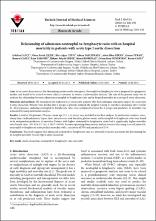| dc.contributor.author | Lafçı, Gökhan | |
| dc.contributor.author | Çiçek, Ömer Faruk | |
| dc.contributor.author | Uzun, Hacı Alper | |
| dc.contributor.author | Yalçınkaya, Adnan | |
| dc.contributor.author | Diken, Adem İlkay | |
| dc.contributor.author | Turak, Osman | |
| dc.contributor.author | Çağlı, Kumral | |
| dc.contributor.author | Taşoğlu, İrfan | |
| dc.contributor.author | Gedik, Hikmet Selçuk | |
| dc.contributor.author | Korkmaz, Kemal | |
| dc.contributor.author | Günertem, Orhan Eren | |
| dc.contributor.author | Çağlı, Kerim | |
| dc.date.accessioned | 2019-05-13T09:02:46Z | |
| dc.date.available | 2019-05-13T09:02:46Z | |
| dc.date.issued | 2014 | |
| dc.identifier.citation | Lafçı, G., Çiçek, Ö. F., Uzun, H .A., Yalçınkaya, A., Diken, A. İ., Turak, O., Cagli, K., Taşoğlu, İ., Gedik, H. S., Korkmaz, K., Günertem, O. E., Çağlı, K. (2014). Relationship of admission neutrophil-to-lymphocyte ratio with in-hospital mortality in patients with acute type I aortic dissection. Turkish journal of medical sciences, 44(2), 186-92 . | en_US |
| dc.identifier.issn | 1300-0144 | |
| dc.identifier.uri | https://doi.org/10.3906/sag-1301-136 | |
| dc.identifier.uri | https://hdl.handle.net/11491/1328 | |
| dc.description.abstract | Aim: Acute aortic dissection is a life-threatening cardiovascular emergency. Neutrophil-to-lymphocyte ratio is proposed as a prognostic marker and found to be related to worse clinical outcomes in various cardiovascular diseases. Te aim of the present study was to evaluate the relationship between admission neutrophil-to-lymphocyte ratio and in-hospital mortality in acute type I aortic dissection. Materials and methods: We retrospectively evaluated 123 consecutive patients who had undergone emergent surgery for acute type I aortic dissection. Patients were divided into 2 groups as patients dying in the hospital (Group 1) and those discharged alive (Group 2). All parameters, including neutrophil-to-lymphocyte ratio, were compared between the 2 groups and predictors of mortality was estimated by using multivariate analysis. Results: A total of 104 patients (79 males, mean age: 55.2 ± 14 years) were included in the fnal analysis. In multivariate analyses, cross-clamp time, cardiopulmonary bypass time, intensive care unit duration, platelet count, and neutrophil-to-lymphocyte ratio were found to be independent predictors of mortality. Patients with higher neutrophil-to-lymphocyte ratios had a signifcantly higher mortality rate (hazard ratio: 1.05; 95% CI: 1.01-1.10; P = 0.033). Receiver operating characteristic analysis revealed that using a cut-of point of 8, neutrophil-to-lymphocyte ratio predicts mortality with a sensitivity of 70% and specifcity of 53%. Conclusion: Tis study suggests that admission neutrophil-to-lymphocyte ratio is a potential predictive parameter for determining the in-hospital mortality of acute type I aortic dissection. © TÜBİTAK. | en_US |
| dc.language.iso | eng | |
| dc.relation.isversionof | 10.3906/sag-1301-136 | en_US |
| dc.rights | info:eu-repo/semantics/openAccess | en_US |
| dc.subject | Aortic Dissection | en_US |
| dc.subject | Mortality | en_US |
| dc.subject | Neutrophil to Lymphocyte Ratio | en_US |
| dc.title | Relationship of admission neutrophil-to-lymphocyte ratio with in-hospital mortality in patients with acute type i aortic dissection | en_US |
| dc.type | article | en_US |
| dc.relation.journal | Turkish Journal of Medical Sciences | en_US |
| dc.department | Hitit Üniversitesi, Tıp Fakültesi, Cerrahi Tıp Bilimleri Bölümü | en_US |
| dc.identifier.volume | 44 | en_US |
| dc.identifier.issue | 2 | en_US |
| dc.identifier.startpage | 186 | en_US |
| dc.identifier.endpage | 192 | en_US |
| dc.relation.publicationcategory | Makale - Uluslararası Hakemli Dergi - Kurum Öğretim Elemanı | en_US |


















